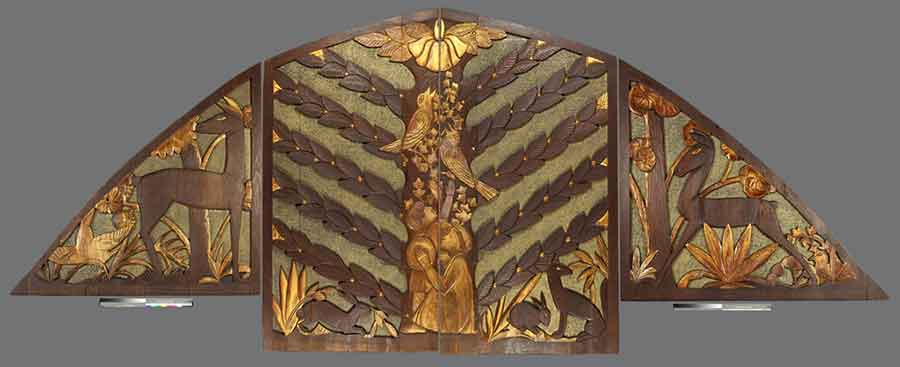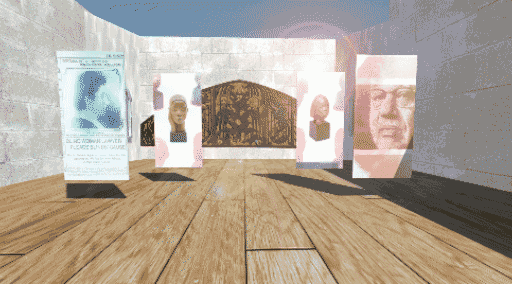The Huntington’s blog takes you behind the scenes for a scholarly view of the collections.
Virtual Model of a Masterful Wood Carving
Posted on Wed., April 24, 2019 by

Sargent Claude Johnson, Screen , 1937, 105 x 264 x 2 in. (266.7 x 670.6 x 5.1 cm.), carved, gilded, and painted redwood. Purchased with funds from the Art Collectors’ Council, the Connie Perkins Endowment, and the Virginia Steele Scott Acquisition Fund for American Art in honor of George Abdo and Roy Ritchie. The Huntington Library, Art Collections, and Botanical Gardens.
I am a digital art historian at the University of California, Berkeley, who studies American and early modern European art. As part of my research, I use technology like laser scanning to capture complex 3D objects, then create digital models to answer questions and explore them in ways not possible with the real things. While at the University of Southern California as a Mellon post-doctoral scholar in Digital Humanities, I teamed up with James Glisson, The Huntington's Interim Virginia Steele Scott Chief Curator of American Art, to laser scan a Sargent Claude Johnson organ screen from 1937—a masterpiece of wood carving by a famed Bay Area, African American artist.
Currently in The Huntington’s collection, it was originally commissioned by the Works Progress Administration, part of the New Deal. The federal government paid Johnson to sculpt a series for the Music Hall of the California School of the Deaf and Blind, then located in Berkeley. In the 1930s, the school was on what is now the university’s campus, and I knew about parts of the commission still in classrooms from my time as a Berkeley graduate student. I had been curious about Johnson’s commission for years and jumped at the chance to partner with Glisson and The Huntington.
The screen was designed for the auditorium of the California School for the Deaf and Blind, the West Coast’s first educational institution for disabled children. Music was central to blind pedagogy, and students put on plays and concerts for their families, as well as the general public. The Huntington sculpture originally hung at the back of the auditorium, placed in front of the organ pipes; sound would travel through the green fabric panels attached to the carved wood frame. And, in this context, the musical symbolism of the sculpture makes a lot of sense; two children, their heads tilted upwards, listen to the chorus of birdsong above, and one seems to strike his tambourine in response. The scenes of the natural world that flank the human figures are especially poignant; groups of animals seem to have been drawn out of the woods to listen. Johnson even left one of the rabbit’s eyes free of the bright gilt that highlights the others, likely to show audience members that animals, too, could be blind.
A 3D model of the leftmost panel of Sargent Claude Johnson’s Screen , 1937.
The screen at The Huntington was scanned with technology that emits beams of concentrated light and times how long it takes for the laser to bounce back from the artwork’s surface. In this way, we were able to create 3D models of each panel that comprises the screen. (One of the 3D models, the leftmost panel, is shown rotating aobve.)
This scan became the raw material that the students in a class I taught at UC Berkeley in Fall 2018 used to build a virtual exhibition. The course, titled “Virtual Reality Development for Art History,” had the goal of developing interactive applications to teach the public about works of art, and the students came from both humanities and computer science backgrounds. The course had the technical goal of teaching students how to use the program Unity, which is standard in the video game business. Microsoft generously donated an Acer mixed reality headset to each student.
Over 14 weeks, the students learned about the artist, African American art, disability studies, and cutting-edge digital art history methods. On the practical side, we collaborated to build a digital museum exhibition with Unity, a computer program for creating virtual reality video games (a GIF of the exhibition is shown below). The GIF shows the first gallery of our virtual reality exhibition. In the background is a 3D model of the Sargent Johnson panel that is still at Berkeley; students digitized historical items (yearbook materials, WPA photos, and census data) related to the California School for the Deaf and Blind to help contextualize the object.

An animation that shows the first gallery of a virtual reality exhibition. In the background is a 3D model of the Sargent Johnson panel that is located at Berkeley; students digitized historical items (yearbook materials, WPA photos, and census data) related to the California School for the Deaf and Blind to help contextualize the object.
In the future, we hope to integrate a full model of the auditorium that will reunite the Berkeley and Huntington panels. (The music hall was substantially remodeled in the 1980s.) By modeling the original room and learning about the kind of organ, we can recreate how the music sounded, allowing virtual visitors to experience the acoustics of the original site.
This was an incredibly rewarding class that linked computer science with humanities in a meaningful, hands-on way. Moreover, we explored many different frameworks within art history—disability studies, African American studies, and digital humanities—and developed a public-facing project that told a long-overlooked and partially lost history. The class itself reflected the potential for digital art history to diversify not only the object stories on display at a museum, but also its audience.
Justin Underhill is academic coordinator of V-Lab at UC Berkeley and editor of International Journal for Digital Art History. He earned his doctoral degree in Art History from UC Berkeley.